Yesterday was a good day for Turkey Vultures. I saw quite a few and photographed several up close, perched and in flight.
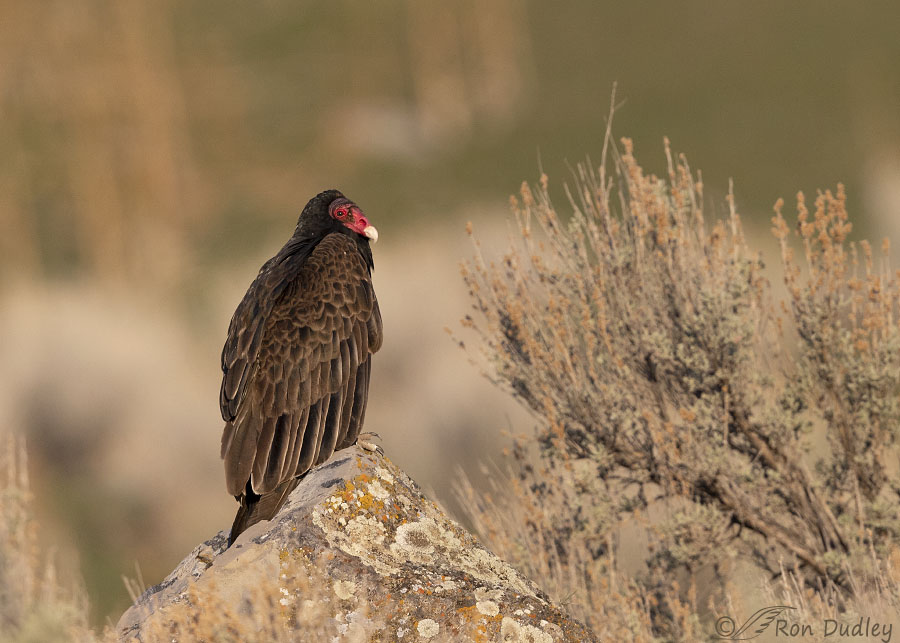
1/2000, f/6.3, ISO 800, Canon R5, Canon EF500mm f/4L IS II USM + 1.4 tc, not baited, set up or called in
Early in the morning temps were in the low 30’s when I got this one in my viewfinder as ‘he’ was warming up with his back to the rising sun. He looked so lethargic I thought he was just going to go back to sleep so I was a little surprised when…
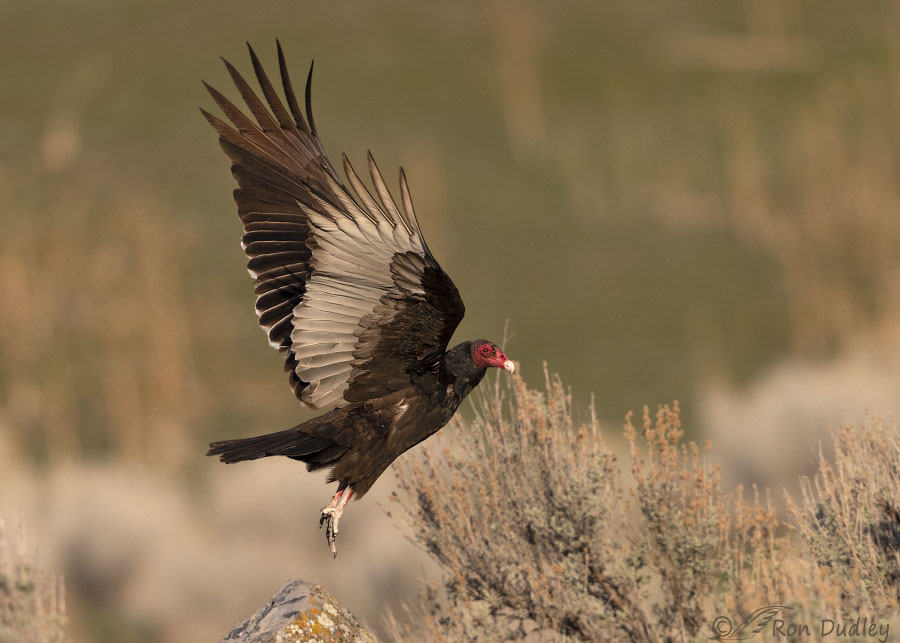
1/2500, f/6.3, ISO 800, Canon R5, Canon EF500mm f/4L IS II USM + 1.4 tc, not baited, set up or called in
he took off. There was sagebrush blocking the first downbeat of his left wing so…
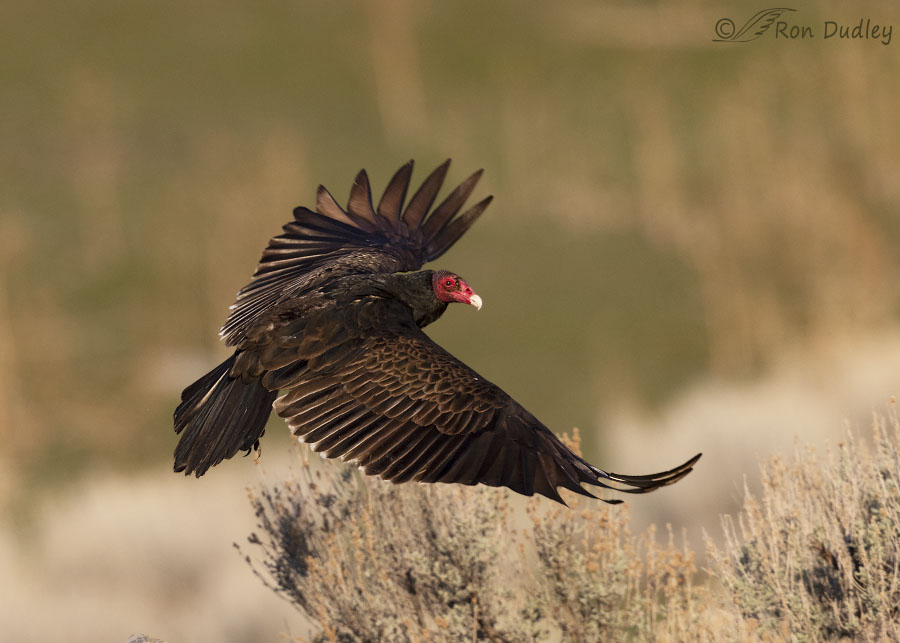
1/2500, f/6.3, ISO 800, Canon R5, Canon EF500mm f/4L IS II USM + 1.4 tc, not baited, set up or called in
he rotated his body a little to his right which allowed a good look at his entire dorsal surface in the warm light. He even gave me a head turn which put good light on his face and provided eye contact in what turned out to be my favorite photo of the series.
When he took off he gained elevation more quickly than I expected (probably to avoid the sagebrush) so I clipped his wings several times.
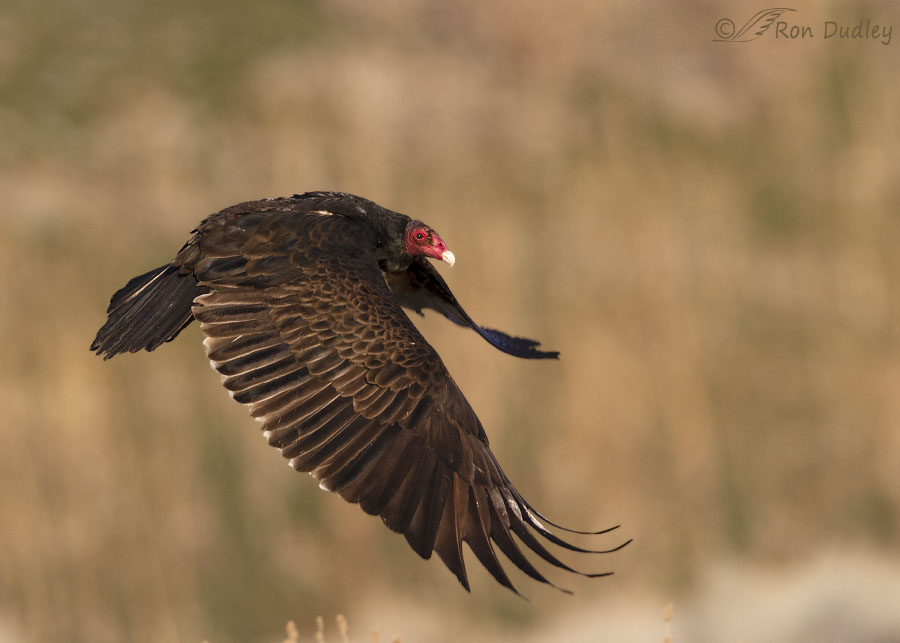
1/2500, f/6.3, ISO 800, Canon R5, Canon EF500mm f/4L IS II USM + 1.4 tc, not baited, set up or called in
Seven frames later I caught him in another flight posture I like.
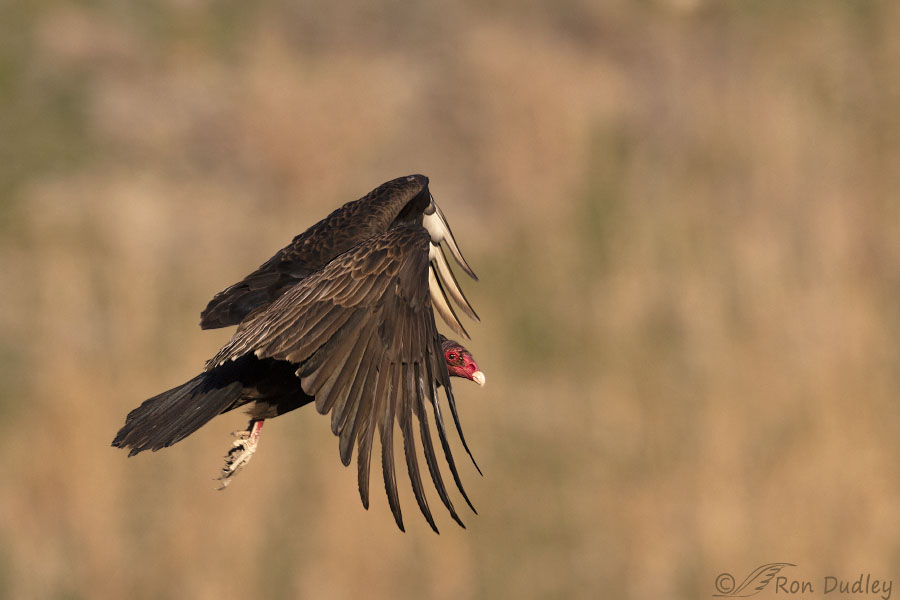
1/2500, f/6.3, ISO 800, Canon R5, Canon EF500mm f/4L IS II USM + 1.4 tc, not baited, set up or called in
After this peekaboo shot he was gone. In this photo my active focus point went astray so his head is a little soft but I decided to include it to show the blood on his right leg. I often photograph raptors with blood from prey on their legs, feet and/or faces but it’s unusual for me to photograph a scavenging vulture with what appears to be fresh blood anywhere on its body.
Photographing black or nearly black birds in very warm morning light typically makes the colors of their very dark feathers look a little funky and these photos are no exception. But these colors are produced by natural conditions and I like the takeoff and flight postures so I decided to be more flexible about it than usual.
Besides, it’s my way of welcoming the vultures back. I’ve missed having them around this past winter.
Ron


As I have said before we have no vultures. So I am starting my morning yet again with a little avian envy.
Thank you.
EC, I recently saw a worldwide range map of squirrels and it didn’t show any in Australia or Greenland, I understand why there aren’t any in Greenland but is it true that Australia doesn’t have any either? I’m betting that some have at least been introduced…? And are there some marsupials that have evolved very similarly to squirrels?
Nope, no native squirrels. Perhaps because they would compete with our native possums.
Two squirrels have apparently been introduced, ‘Squirrels, family Sciuridae are represented in Australia by two introduced species, the American Grey Squirrel (Sciurus carolinensis) Gmelin 1788 and the Northern Palm Squirrel (Funambulus pennantii) Wroughton 1905.’ though I have never seen either.
Interesting. Thank you, EC.
That turkey seems to be smiling directly at you Ron in each shot! LOVE!
Probably thinks I’m funny looking…
Gorgeous shots, Ron! Especially that nakey, red head. Swoon!
Thanks, Marty. The swoon brought a smile.
Beautiful lift of series.
Thanks, April. I hope your owl is still doing OK. Wish I could’ve helped.
I was told the wounds looked good and clean, two stitches were put in, so if inflammation goes down and there is not tissue death from blood loss or infections it should be releasable. Sometimes birds can die from the shock of the trauma so I hope it made it through the night. My rescue kit is back in the trunk. I picked up a fence pliers and some smooth wire so now I need to get out a repair the fence.
I’ll have to double check and make sure I still have my heavy-duty wire cutters in my pickup. I haven’t used them in a long time.
Hi Ron. I think turkey vultures normally have dark red legs and I doubt the red coloration is from blood. The white on the feet is from them defecating on their legs to cool off. A process called urohydrosis.
Wayne
Wayne, adult Turkey Vultures have pink legs and I thought this red looked a little dark for that. But you could be right that it isn’t blood. Maybe it’s just the warm light on the leg that makes it look so red..
At first I thought that might be the same rock the Chukar was on, but looking back it looks different.
Very nice shots. I have often watched the Turkey Vultures here warming up and spreading their wings and if you can ignore the face for a moment, they are very beautiful birds especially when you look at their wing spread.
Nope, not the same rock Everett. These shots were taken many miles north of Antelope island. Agreed, their naked head is hard to love for some folks.
Beautiful! Love how the feathers show as a rich brown in the warm light.
Thanks, Judy.
What a beautiful series. You absolutely nailed the take off. You have also captured the stunning beauty of his wing feathers. Who knew vultures could be so appealing.
Thank you, Lyle. I think they’re appealing, even with their naked heads and their almost perpetually messy plumage.
The Black vultures are back too! I’ve got a story to share too. My good friend in East Texas has an “abandoned” rear porch he enclosed 20 years ago. Last year two Black vultures raised two chicks in it, and their poop upset my neighbor greatly. When they all flew the coop, he walled-up the entry to prevent their return. He’s a cantankerous old man. Last week the vultures returned and he saw two eggs on the dirt floor which upset him greatly. He got a box ready to move the eggs and said he was going to again wall-up the porch where they had found a place to re-enter. Pleadings and emotional implorings won’t work with this man, so I sent him a webpage with photos of cute fuzzy chicks, and info about the charming Black Vultures and how diligently they raise their famil. Plus they’re monogamous for life, a rarity now a-days. A few days later I called him on the phone, and he said he decided to leave them be, they will be allowed to raise their family THIS YEAR but come this fall, his soft spot ceases and he will do a better job of boarding-up his rear porch.
Loved the story, Terri. I guess even cantankerous old men can have soft spots.
Terri, that is a great story and illustrates a typical nesting behavior for black vultures. They definitely like “abandoned” buildings and also return to the same spot year after year (when they can). We actually have a semi-abandoned (used very infrequently) barn (I’m in Maryland), and black vultures have been nesting in a small grain room inside for about ten years. It seems they may be a second generation nesting in the same spot, but I’m not sure on that. They currently have two eggs that should be hatching out in a week or so (laid in early March). Black and turkey vultures stay year round in central Maryland, so we see them all winter. Vultures are wonderful birds.
Great photos Ron. I like the in-flight one with the head turn best also.
Duane.
Thanks, Duane.
Wonderful. Well done Terri. And thank you.
Wonderful series, Ron!! vultures are such i important raptor in our world. Where I live in South East, Florida we don’t have Turkey Vultures – we have Black headed Vultures which look very majestic and as you captured – so handsome when flying!!
Thank you, Jo Ann. I’ve read a lot about Black Vultures but I’ve never seen or photographed them.